Students can go through AP State Board 10th Class Biology Notes Chapter 8 Heredity to understand and remember the concept easily.
AP State Board Syllabus 10th Class Biology Notes Chapter 8 Heredity
→ Variations arising during the process of reproduction can be inherited.
→ Variations may lead to increased survival of the individuals.
→ Gregor Johann Mendel known as the father of genetics started working on the problem of how variations were passed from one generation to another.
→ Mendel had chosen 7 pairs of contrasting characters in pea plants for his study: flower colour, flower position, seed colour, seed shape, pod colour, pod shape and stem length.
→ The Pea plant is an annual plant that contains vitamins A, C, E, K and B and minerals like Ca, Fe, Mn. Mg, P, S and Zn.
→ Cross-pollinating a pure breed of yellow and green gave all pea seeds in the F1 generation were yellow.
→ On self-pollination plants of Ft generation, they gave about 75% yellow seeds and 25% green seeds in the F2 generation.
→ The phenotype ratio of F2 plants is 3: 1.
→ In the F2 generation out of 75%, 25% were pure yellow seeds, 50% were yellow seeds but green was a recessive factor. The remaining 25% were pure green. This is called genotype. The ratio is 1: 2: 1.
→ In the F3 generation, Mendel self-pollinated F2 generation pea plants and found that about 25% gave only yellow seed giving pea plants, the rest of the yellow pea plants gave about 75% yellow and about 25% green seed giving pea plants.
![]()
→ And the set of green peas gave only green seed giving pea plants.
→ Every pea plant has two factors that are responsible for producing a particular property or trait called “allele”.
→ During sexual reproduction, one factor from each parent is taken to form a new pair in the offspring.
→ Crossing yellow and green seeds produced all yellow seeds because yellow is the dominant factor.
→ In the inheritance of more than one pair of characters, the factors for each pair of characters assort independently of the other pairs. This is known as Law of independent assortment.
→ The factors which are responsible for the character or trait of an organism, are now named genes.
→ Law of dominance states that among a pair of alleles for a character only one expresses itself in the first generation, as one of the alleles is dominant over the other.
→ The Law of segregation states that every individual possesses a pair of alleles for any particular trait and that each parent passes a randomly selected copy (allele) of only one of these to its offspring.
→ Traits that may be passed from one generation to the next are called heritable traits.
→ Sexual reproduction and errors in DNA copying lead to variations in offspring in a population.
![]()
→ Change in the frequency of genes in small populations is known as genetic drift.
→ Jean-Baptist Lamarck was the first person to propose the theory of evolution. He proposed the inheritance of acquired characters.
→ Characters that are developed during the lifetime of an organism are called acquired characters.
→ August Weismann proved that bodily changes are not inherited.
→ Charles Darwin proposed the famous theory of evolution called Natural Selection.
→ Transmission or passing of characters or traits from parent to offspring is called Heredity.
→ The process in which traits are passed from one generation to another generation is called Inheritance.
→ Gene is a segment of a nucleic acid called DNA which is present in the nucleus of every cell.
→ The detailed structure of DNA was discovered by Francis Crick and James Waston.
→ Each human cell contains 23 pairs of chromosomes out of which 22 pairs of chromosomes are autosomes.
![]()
→ 1 pair of chromosomes are called allosomes or sex chromosomes.
→ Gametes produced by women will be with only ‘X’ chromosomes.
→ Gametes produced by man will be of two types one with X chromosomes and the other with Y chromosomes.
→ If the sperm carries the X chromosome and fertilizes the ovum with the X chromosome, the resultant baby will have XX condition. So the baby will be a girl.
→ If the sperm carries the Y chromosome and fertilizes the ovum with the X chromosome, the resultant baby will have XY condition. So the baby will be a boy.
→ According to the theory of Natural selection, nature only selects or decides which organism should survive or perish in nature.
→ Alfred Russel Wallace concluded that natural selection contributed to the origin of new species.
→ Walter Setton and Thomas Morgan conducted experiments on (fruit fly) Drosophila melanogaster about sex-linked inheritance in them.
→ In the struggle for existence, only the fittest can survive.
→ Darwin published his famous book The origin of species’ in 1859.
![]()
→ The small changes within the species are called Micro Evolution.
→ The changes beyond the species are called Macro Evolution.
→ The organs which perform different functions but have similar structures and origins are called homologous organs, eg.: Forelimb of whale, a wing of bat. leg of cheetah, the claw of a mole and the hand of man.
→ The organs which are similar in appearance and function, but have different structures and origins are called analogous organs, eg.: Wings of butterflies, bats and birds.
→ Embryology is the study of the development of an organism from egg to the adult stage.
→ The developmental stages of different animals reveal that they are evolved from common ancestors.
→ Preserved traces of living organisms are called fossils.
→ The study of fossils is called palaeontology.
→ Archeopteryx is recognised as connecting link between Aves and reptiles.
→ Human evolution is the evolutionary process leading up to the appearance of a modern human being.
![]()
→ There are nearly 180 vestigial organs are present in human beings.
→ Variations: Differences in characters within closely related groups of organisms are referred to as variations. They result in organisms belonging to a species being different from each other.
→ Offsprings: The organism or organisms resulting from sexual or asexual reproduction. The product of the reproductive processes of an animal or plant.
→ Traits: A distinguishing characteristic or quality, typically one belonging to a person or animal.
→ Phenotype: It is the composite of an organism’s observable characteristics or traits such as its morphology, development, etc.
→ Genotype: It Is the genetic makeup of an individual usually with reference to a specific characteristic tinder consideration.
→ Heterozygous: It refers to have two different alleles for a single trait.
→ Homozygous: Homozygous refers to have two identical alleles for a single trait.
→ Independent assortment: It states that allele pairs separate independently during the formation of gametes.
→ Allele: It is an alternative form of a gene that is located at a specific position on a specific chromosome.
→ Heredity: The process of acquiring characters or traits from parents to offspring.
![]()
→ Autosomes: An autosome is any chromosome that is not a sex-determining chromosome. In humans, there are 22 Pairs of autosomes.
→ Allosomes: Sex determining chromosomes that differ from an ordinary autosome in size, form and behaviour human sex chromosomes are a typical pair of sex chromosomes.
→ Natural selection: Darwin’s most famous theory. A process resulting in the survival of those individuals from a population of animals or plants that are best adapted to the prevailing environmental conditions.
→ Analogous organs: Organs that have similar appearance and functions but have different structures and origins. eg.: Wings of butterfly, of a bat and of a bird.
→ Embryological: Evidence available from the embryonic development of evidence organism for organic evolution.
→ Human evolution: It Is the evolutionary process leading to the appearance of anatomically modern humans.
→ F1 Generation: FIrst filial or progeny of first-generation. The first generation was produced by a cross and consisting of hybrid organisms.
→ F2 Generation: The generation produced by interbreeding individuals of an F1 generation.
→ Gene: A gene is the basic physical and functional unit of heredity. Gene is a working subunit of DNA.
→ Dominant gene: Gene that produces the same phenotype in the organism whether or not its allele is identical.
![]()
→ Recessive gene: Gene that produces its characteristic phenotype only when its allele is identical.
→ Inheritance: The process in which traits are passed from one generation to another generation.
→ Evolution: Evolution is a change in heritable traits of biological populations over successive generations.
→ Genetic drift: It is the change ¡n the frequency of genes in a small population.
→ Acquired characters: The characters that are developed during the lifetime of an organism are called acquired characters.
→ Microevolution: Evolutionary change within a species or small group of organisms, especially over a short period.
→ Macroevolution: Macroevolution generally refers to evolution above the species level.
→ Homologous organs: The organs which perform different functions but have similar structures and origins. eg.: Wing of the bat, the flipper of a seal, front leg of a horse, an arm of a man, etc.
→ Subtle: So delicate or precise as to be difficult to analyse or describe.
→ Ancestors: Ancestors ¡s any person from whom one is descended.
→ FossIl: These are evidence of ancient life forms which have been preserved by natural processes.
→ Palaeontology: The study of fossils is called Palaeontology.
![]()
→ Vestigial organs: The organs which are not useful in animals are called vestigial organs.
→ Heredity:
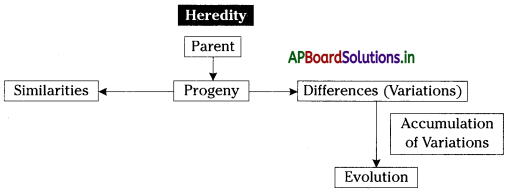
→ Monohybrid cross:
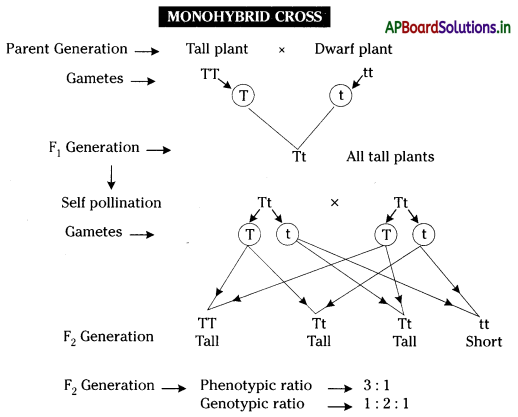
→ Sex Determination in Human:
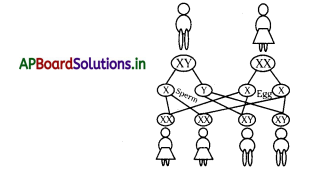
→ Mechanism of Heredity:
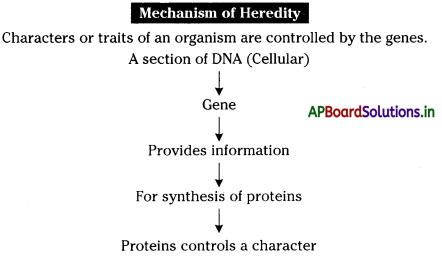
→ Genetic Drift:
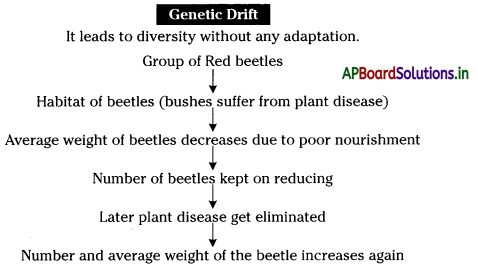
→ Human Evolution:

→ Genetic footprints of Humans hundreds/thousands of years ago Earliest members are in Africa:

![]()
→ Gregor Johann Mendel (1822 – 1884):
- Gregor Johann Mendel was considered as ‘Father of Genetics’.
- He was the first person to trace the characteristics of successive generations of a living thing.
- He was an Augustinian monk. So he did all his experiments in the monastery garden.
- Mendel made many careful observations of plants and chose pea plants for his experiments through which he made the law of inheritance.
- His work was so brilliant and unprecedented at the time it appeared, that it took thirty-four years for the rest of the scientific community to catch up to it.